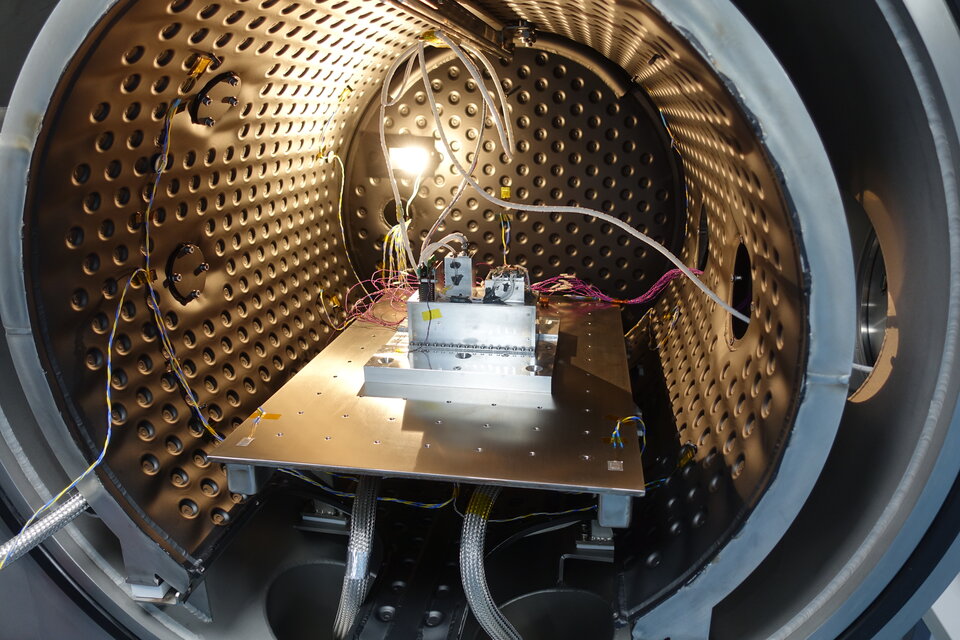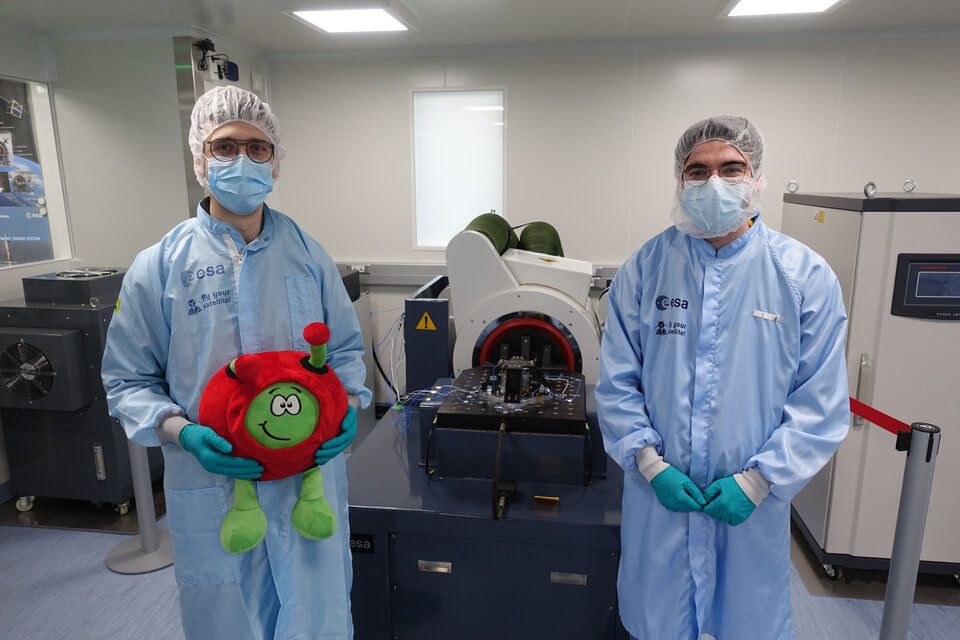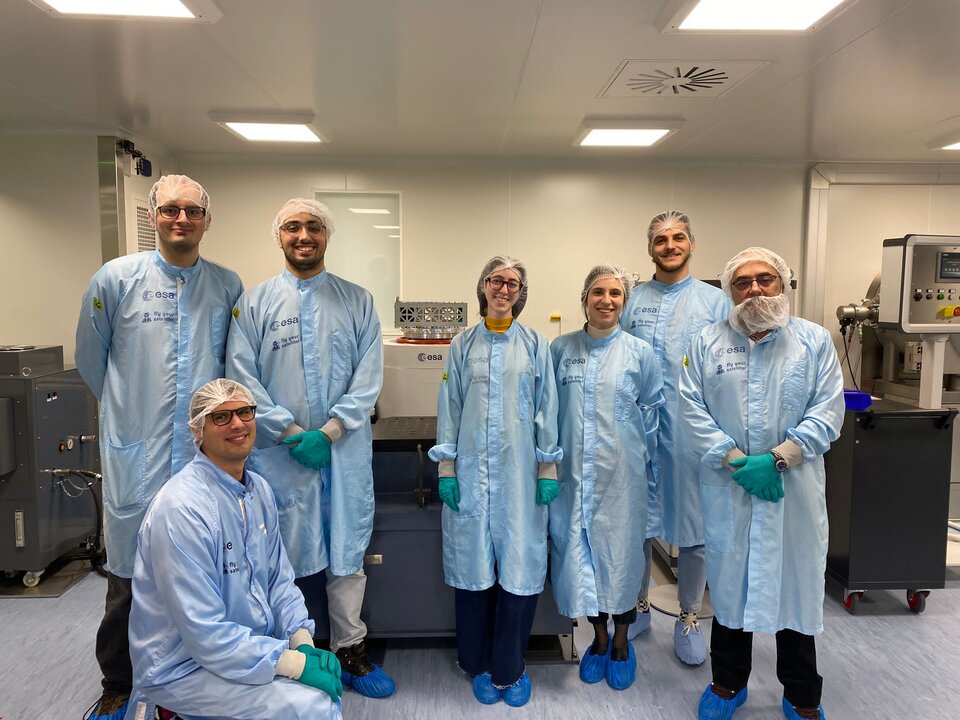Test Opportunities proposal instructions
ESA invites university student teams from an eligible state that would like to receive support in the preparation of their space project environmental testing as well as access to the CubeSat Support Facility (CSF), to apply to Test Opportunities.
How to Apply
Interested in applying to Test Opportunities? You should then do the following:
- Ensure your team is eligible and meets the conditions to apply (see section below)
- Request the “Test Opportunities: Facility Handbook and Requirements” document.
- Check the available Test Windows in the programme timeline page.
- Upload the following documents to the online registration in PDF format no later than the deadline indicated in the Call for Proposals:
-
Test Proposal
Download the template here.
Carefully read the guidelines described within the document.
PDF file name: “Test-Opportunities_Proposal_TeamName” -
Endorsement letter
The letter of endorsement from the professor responsible for the project
PDF file name: “Test-Opportunities_Proposal_TeamName_endorsement-letter”
-
Test Proposal
Proposals that do not comply with the requirements provided in the conditions to apply (section below) may be rejected without being reviewed further. The information provided in the proposals will be treated as confidential and will only be distributed to and reviewed by the ESA Panel for the purpose of the evaluation. The contact person indicated in the proposal may be contacted by ESA for further clarifications during the proposal evaluation period.
Any questions regarding applications can be directed to cubesats@esa.int.
Conditions to apply and practical programme information

1. Scope of the project
Test Opportunities is open to university student teams from an eligible state, working on the development of space hardware or conducting investigations in the space engineering or space science domain.
The scope of the proposed test campaign shall be educational, and the proposal shall clarify in which way the educational objectives will be pursued.
Student team members are encouraged to prepare theses on subjects (e.g., technological, engineering, scientific…) related to their project. This shall be reflected in the proposal, and ESA will consider this as an educational asset.
By participating in the programme teams will not receive any endorsement, validation or certification from ESA of the qualification status of the test item.
Whilst not a selection criterion, teams should state clearly in their proposal how their experiment and project objectives align with the seventeen United Nations Sustainable Development Goals (SDGs), and the ESA Strategic Goals. Teams are encouraged to choose the goals that align closest to their project and describe in detail how their project aligns with that specific goal.

2. Test Campaign
Selected teams will be granted access to conduct a test campaign at the CubeSat Support Facility, and will be guided in the preparation, execution and result processing of the test.
The CubeSat Support Facility is a cleanroom designed to perform integration activities and environmental tests on CubeSats and their subsystems. It can also accommodate AIV activities of other units, such as sounding rocket, high-altitude balloon and microgravity experiments, and other small-scale equipment and payloads. The “Test Opportunities: Facility Handbook and Requirements” document is available upon request. Test facilities available at the CSF are:
- 20kN Electrodynamic Shaker
- Thermal Vacuum Chamber (-60degC/+100degC, >=10-6 mbar)
- Vacuum Oven (<=+200degC, >=10-2 mbar).

4. Test item requirements
The opportunity is open for educational, space-related hardware testing compliant with the CubeSat Support Facility technical requirements.
At the time of application, the item should be fully designed, and ready to be tested by the time of the selected test window. The design and manufacturing of the test adapters shall remain compatible with the overall timeline of the test campaign.
Specific requirements on volume, dimensions, mass, cleanliness, materials, interfaces, etc. are listed in the “Test Opportunities: Facility Handbook and Requirements”, which can be requested by filling out this form.
Additional adapters and hardware are to be provided by team. The proposal shall include a proposed set-up for the unit, and the adapter’s estimated development time and costs. The specific details will be agreed well before the campaign. The facility does offer a set of CubeSat standard adapters available to visiting teams upon coordination with facility.
5. Team Composition
The opportunity is open to University student teams from universities of an eligible state. The core team should be composed of a minimum of four (4) students per week, a maximum of 8 students are eligible for travel reimbursement all of which must fulfil the eligibility criteria:
- Aged minimum 18 years old;
- Be a citizen of an eligible state;
- Enrolled as a full-time bachelor, master or PhD student (or equivalent) at a university of an eligible state

The total number of students that can personally assist and participate in the execution of the test campaign (should the team be selected) will depend strictly on the capacity of the CubeSat Support Facility and the role assigned to each participant. Final arrangements will be taken during the test preparation phase. There is no limitation on students participating in programme phases excluding the test execution where the limitation is dictated by cleanroom requirements. Students not participating in the test campaign on-site will be invited to participate remotely via live stream. The whole team will be invited and encouraged to attend test reviews and other meetings with ESA.
The initial composition of the team should not be changed throughout the programme. If, for exceptional reasons, changes are necessary, they will be subject to the approval of the ESA Education Office.
Teams may include a limited number of students that do not comply with the eligibility criteria above, but those students will not be supported by ESA for participation in programme events, nor for training.
6. Team Funding
The teams participating in Test Opportunities shall rely on their own sponsors for the development of the test hardware, and any test-related items (e.g., test adapters not available in the CSF).
7. ESA Sponsorship
ESA contribution in the support of the participating student teams will include the following:
- Support offered by the ESA Education personnel that run the programme, and by the ESA specialists who will lecture, follow up, and review the student activities;
- Access to and use of test facilities;
- Student sponsorship for travel and accommodation for the participation in training events (if any), and the test campaign(s) at the CubeSat Support Facility.
Students who may directly benefit from the different forms of sponsorship that the ESA Education Office will offer must comply with the eligibility criteria. Students that do not meet the eligibility criteria cannot be sponsored by the ESA Education Office.
8. Endorsement Letter
The teams will have to be supported by one of their professors or academic supervisors, whose role will be to supervise the work of the students. This person must belong to the same institution of at least one of the students, is expected to endorse the entire application and development process of the team and will bear responsibility for the experiment.
Only one proposal per university faculty or department can be considered for the proposal to Test Opportunities. The faculty or department will be asked to withdraw the other proposals in case of multiple applications.
If the proposed project is a joint undertaking of multiple parties (e.g. two universities collaborating on one mission), one single university shall act as the leading university and the key point of contact vis-à-vis ESA. The collaborations with other organisations or institutions shall be clarified in the proposal, including a description of the mutual agreements.
9. Ranking and selection
All proposals will be reviewed and decisions regarding rankings and selections of teams will be taken by ESA. The selection criteria will include, and are weighted as:
- Educational return and content (Weight factor: 40%);
-
Feasibility of the proposed test (Weight factor: 30%)
Note: Teams are requesting to fill in the proposal to the best of their knowledge indicating knowledge gaps to which ESA Academy can support , if any; - Team and project organisation (Weight factor: 20%);
- Technical or scientific objectives(Weight factor: 10%).
To ensure that the programme can be implemented in a defined time period, the number and complexity of the projects should match the resources and capabilities of the programme. For this reason, ESA shall only select as many projects as can be realistically implemented, taking into account the existing hardware and work plan.
If two proposals are of equal quality, priority will be given to teams and/or projects that have not been launched by the Education Office or did not yet participate in Fly Your Satellite! or other ESA Education Office programmes.
10. ESA Academy Code of Conduct
Everyone who participates in Test Opportunities is a participant in the ESA Academy programme. Therefore, all participants are subject to the ESA Academy Code of Conduct.
11. Personal Data Protection
As part of their participation in the opportunity, CubeSat teams must provide ESA with certain personal data. Which data is collected, the purposes it is used for, to whom it may be disclosed, and how long it’s kept for are all covered in the ESA Academy Privacy Notice and consent form, which should always be available on the ESA Academy webpages, and agreement with which must be made before submitting personal data to ESA.

